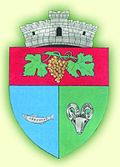Ighiu
|
Ighiu Grabendorf / Krapundorf Magyarigen |
||||
|
||||
| Basic data | ||||
|---|---|---|---|---|
| State : |
|
|||
| Historical region : | Transylvania | |||
| Circle : | Alba | |||
| Coordinates : | 46 ° 9 ' N , 23 ° 31' E | |||
| Time zone : | EET ( UTC +2) | |||
| Height : | 281 m | |||
| Area : | 128.49 km² | |||
| Residents : | 6,283 (2011) | |||
| Population density : | 49 inhabitants per km² | |||
| Postal code : | 517360 | |||
| Telephone code : | (+40) 02 58 | |||
| License plate : | FROM | |||
| Structure and administration (as of 2016) | ||||
| Community type : | local community | |||
| Structure : | Ighiu, Bucerdea Vinoasă , Ighiel , Șard , Țelna | |||
| Mayor : | Traian Rusu ( PNL ) | |||
| Postal address : | Str. Principală, no. 369 loc. Ighiu, jud. Alba, RO-517360 |
|||
| Website : | ||||
Ighiu (outdated Igiu ; German Grabendorf or Krapundorf , Hungarian Magyar ) is a Romanian municipality in the Alba district in Transylvania .
The place is also known by the German names Krabundorf and Kuppendorf .
Geographical location
Ighiu is located on the stream of the same name - a tributary of the Ampoi - on the southeastern edge of the Trascău Mountains in western Transylvania . Three kilometers from Drum național 74 ( Zlatna - Alba Iulia ) and the Șard Ighiu station - on the Alba Iulia – Zlatna railway that went into operation in 1895 and converted to standard gauge in 1984 - the place is about ten kilometers northwest of the district capital Alba Iulia.
history
The place was first mentioned in 1206 under the name Villa Crapundorph . It was founded by Transylvanian-Saxon settlers. Due to the devastating Mongol invasion in 1241, the number of German residents decreased significantly. The Hungarian form Iguen is documented in 1299, the current Romanian name Ighiu in 1850. Over the centuries, Hungarian and Romanian residents increasingly dominated the village. They lived and live from agriculture and viticulture.
population
Of the approximately 6500 inhabitants of the municipality, around 1200 live in the actual village of Ighiu. In 2002, 1124 of the 1244 inhabitants then referred to themselves as Romanians . In addition, 106 Roma , 13 Hungarians and one member of another nationality lived in the village. For the last 100 years there has been an increasing assimilation of the Hungarian population. In 1910, for example, around a third of the residents of Ighiu were still Hungarian as their nationality.
In 2002 a total of 6432 people lived in the entire municipality, of which 6170 Romanians, 227 Roma, 30 Hungarians, 4 Romanian Germans and 1 Italian .
The highest number of Germans (61) on the municipality's territory was counted in 1880, Hungarians (595) in 1880 and 1890, and Roma (355) in 1977.
Attractions
- The Romanian Orthodox Church Cuvioasă Paraschiva (1724, bell tower 1761) is a listed building.
- Remains of fortifications of the Reformed Church from the 15th-18th centuries Century. The Reformed Church (formerly Protestant) and the rectory (built in the 18th century) are listed as historical monuments.
- In the incorporated village of Ighiel ( Igensbach ) the orthodox church Cuvioasa Paraschiva , built in the 18th century, is a listed building.
Personalities
- Péter Bod (1712–1769), Reformed pastor
Web links
Individual evidence
- ↑ Mayoral elections 2016 in Romania ( MS Excel ; 256 kB)
- ^ Dictionary of the localities in Transylvania
- ↑ Census, last updated October 30, 2008, p. 97 (Hungarian; PDF; 1.2 MB)
- ↑ a b c List of historical monuments of the Romanian Ministry of Culture, updated 2010 (PDF; 7.10 MB)
- ↑ Who was Péter Bod? at www.bodpeteralapitvany.ro/en/ accessed on January 29, 2016



